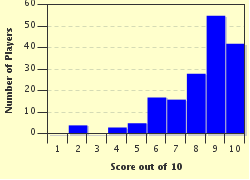Quiz Answer Key and Fun Facts
1. In this map, made up of scans taken from satellite imagery, which mountain range can be seen running the length of South America?
2. This map shows what important river basin, feeding one of the world's longest rivers. Which of the following river systems is depicted in the image?
3. This image shows the Atacama Desert. In which South American country is the Atacama Desert largely located?
4. This next image shows the Brazilian city of São Paulo at night. Yes or No, is Sao Paulo one of South America's most populous cities?
5. This image shows the Galápagos Islands from space. Which South American country controls these islands?
6. This image shows Lake Maracaibo. In which South American country is this lake situated?
7. This satellite image shows the Nazca lines from space. In which South American country are these lines located?
8. This image shows part of the Salar de Uyuni in Bolivia, taken from space. Which of the following resources can be found in this lake?
9. This picture shows an image of Tierra del Fuego from space. What in English does Tierra del Fuego mean?
10. This final picture is of which lake in South America, bordered by Bolivia and Peru?
Source: Author
mcsurfie
This quiz was reviewed by FunTrivia editor
Tizzabelle before going online.
Any errors found in FunTrivia content are routinely corrected through our feedback system.

